Thank you to each of my students who took the time to complete a student evaluation of teaching this year. I value hearing from each of you, and every year your feedback helps me to become a better teacher. As I explained here, I’m writing reflections on the qualitative and quantitative feedback I received from each of my courses.
This is my second time teaching Psyc 218: Analysis of Behavioural Data, and I must say, I truly love teaching students this course. I didn’t make many changes from the last time, with two exceptions: (1) I attempted to even out the midterm difficulty in response to feedback and self-analysis from last time, (2) I integrated a new reading and treatment of the “New Statistics” debate/movement going on in our discipline right now. I didn’t change the textbook, overall teaching methods (largely lecture punctuated frequently by clicker questions where students practice calculations and interpretation), or the assignments (which we all have to do across sections).
Like last time, quantitative feedback was quite positive, and even a bit higher than last time (e.g., 4.7/5 on average for the “overall efficacy” item, up from 4.4; see the graph above). Qualitative feedback helps me to figure out specifics of what’s going well and what isn’t. Overwhelmingly, the most common comments noted the energy and enthusiasm I bring to class – which was awesome. I really had fun every day, so I’m glad I can help students build positive vibes toward statistics. Quite a few students commented on the high expectations I have for them: indeed, this course is challenging. Some students felt they were appropriately supported to rise to the challenge, whereas others felt pushed a bit too far. Given the differences there, I think the course is probably pitched at an appropriate level, at least when coupled with the way I handled it. Quite a few students asked for more problems to practice with. There are about 30 in the book at the end of each chapter, and every day in class there are clicker questions. However, I know that very few of these problems are at the high level of difficulty I ask for on exams. I wonder if I could offer students a model of how to take a research paper (of which there are a gazillion they could find on their own) and turn it into a problem set. Is there a common set of questions students could ask to help them link the course material to a research article? Hmm. Think more about how to help students learn how to make their own problems/examples. That will be more useful in the long run for the students than me trying to come up with a whole pile of artificial ones.
I was delighted with the number of students who mentioned that incorporating the New Statistics (vs. NHST) framework was motivating and engaging. In the context of discussing these current issues, one student wrote,
“I think that’s really important in terms of training us to be strong, statistically sound researchers. As well, it made me feel like I’m truly part of this field, instead of just being a student taking a course. Overall I would give Dr. Rawn an A+ because she has truly changed the way I think about statistics and about the field in general.”
The identity shift that this student in particular expresses is profoundly important to me. This and similar comments like it bolster my belief that incorporating current issues in statistics and research methods is crucial when training the next generation of psychological scientists. Overall, I’m quite pleased with how this course went, and overall the students seem to be as well.


 Follow
Follow